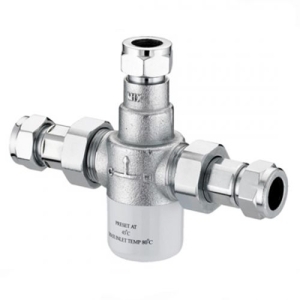TMV: An In-depth Guide to Thermostatic Mixing Valves

A thermostatic mixing valve is an essential component in modern plumbing systems - both to ensure the safety of users and compliance with the law. Necessary for controlling the temperature of water, understanding what a thermostatic mixing valve, or TMV, is and how they work is crucial, particularly in commercial wash spaces.
Find out more about Thermostatic Mixing Valves
What is a TMV?
A thermostatic mixing valve is a device that blends hot water with cold water in order to maintain a consistent and safe temperature at the outlet. Typically, a TMV will contain a temperature-sensitive element, for example, a wax capsule or bimetallic strip, allowing it to adjust the mixing ratio based on changes to the water temperature.
In 2010, it became a legal requirement for all commercial and domestic new builds, as well as properties approved for change of use, to install TMVs. These regulations stipulate that TMVs must be able to maintain a stable temperature of under 48°C and quickly be able to shut off in the event of either hot or cold water failure.
TMVs work by using the temperature-sensitive element to sense changes in the water temperature. Then, the adjustment mechanism is able to provide more or less hot or cold water supply in order to achieve the desired temperature. The mix of hot and cold water is balanced in order to achieve and maintain a consistent temperature.
Should the cold water fail, the TMV will shut off to prevent dangerous water temperatures that could lead to burns. On the other hand, in the event of hot water failure, the TMV will similarly switch off in order to prevent thermal shock.
The Purpose of TMVs
TMVs are an essential component for both the safety and comfort of your users. Their primary purpose is to prevent scalding. TMVs work to regulate water temperature at the outlet. This ensures the water is never too hot, and dramatically reduces the risk of burns. Even when there are fluctuations in the hot and cold water supply, the temperature-sensitive element allows TMVs to maintain consistent temperature. They are most commonly used in sinks and shower and bathing facilities, and are particularly important in hospital or care facility equipment.
TMVs also serve another important function - controlling the growth of legionella bacteria. Legionella bacteria is naturally occurring, and thrives in the temperatures necessary to ensure water does not scald the skin. Therefore, hot water needs to be stored at a higher temperature in order to effectively kill the bacteria. TMVs maintain water temperatures that reduce the growth of this bacteria, while allowing the water flow at the outlet to remain a comfortable temperature for the skin, thus reducing the risk of disease being spread. In hospitals or hotel washrooms, this is of particular importance.
Installing and Maintaining TMVS
Typically, a TMV should be installed near the point of use - for example, under sinks or inside shower systems. Depending on the intended use, it is important to ensure you are using the right type of TMV valve - for example, you may require a TMV2 or TMV3 depending on what kind of establishment the valve is required in.
If you have a TMV installed, conducting regular testing and maintenance to ensure the valve is functioning correctly should be an essential part of your washroom maintenance. This usually involves checking the temperature settings and flushing the valve if required.
Both TMV2 and TMV3 devices require annual service checks, and preventative servicing on a yearly basis is also recommended. During the service, the temperature control will be checked, and the TMV device will be cleaned, descaled, and disinfected to prevent bacteria growth.
The Importance of TMVs
Thermostatic mixing valves play a crucial role in ensuring the safety and comfort of users by preventing scalding and maintaining consistent water temperatures. Proper installation, regular maintenance, and compliance with relevant standards will help keep your washroom users safe, comfortable, and allow for the maximum efficiency of your washroom equipment.
For more information, get in touch with our team.
